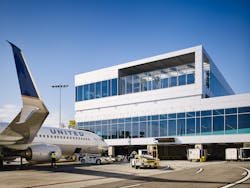Airport design and construction is a complex process that involves a variable mix of infrastructure — from terminals, taxiways and runways, to parking lots, car rental centers, cargo facilities, and the transportation networks that serve them. To efficiently serve the growing global travel population, creating a safe, modern, and stress-free travel experience is essential.
Design professionals recognize that airport complexes must consider and carefully balance spatial, technical, and operational challenges and cannot be designed in isolation. Holistic airport design takes an approach that views the entire airport and its infrastructure as an interconnected whole that is part of a larger entity. Utilizing holistic design approaches to complex airport infrastructure projects not only benefit the airports’ diverse stakeholders, but most importantly, its passengers.
Holistic airport design considerations involve a variety of different elements.
Regional identity
Airports today are placing more importance on the concept regional identity, providing a sense of place that clearly reflects the city where the airport is located. As the gateway for arriving travelers, airport design can reflect regional characteristics and unique qualities through:
- Concession choices - offering a unique experience with local/regional eateries/craft breweries etc. and popular local restaurants
- Selection of sustainable local building materials
- Referencing significant architectural and historic design elements
- Curated artwork by local artisans
- Geographic and climatic influences (e.g. in Southern California, offering seamless indoor/outdoor space transitional opportunities)
Civic Pride
Harnessing civic pride is a significant driver across the country and encompasses transportation, urban design and overall branding of the city. As cities compete for national and international recognition, their airports are actively enhancing their facilities by showcasing the city’s essence. Airports are economic engines that support the local economy and modern, state-of-the-art airports are an increasing source of pride.
For San Diego International Airport Terminal 2 West Building and Airside Expansion, HNTB was the designer, lead architect of record, and engineer for the 526,000-square-foot expansion. Major public art installations were incorporated into the design as part of SAN’s Arts Program that surprise and delight travelers by showcasing San Diego’s rich cultural community. Through artwork exhibitions and programs that engage travelers in innovative, memorable, and considerate experiences, the airport enhances the customer experience by creating an ambiance unique to San Diego and welcomes people to the airport and the region.
Passenger experience
Most passengers agree that air travel is not as pleasant as it once was. Airport design professionals believe we can recreate some of the magic of the mid-20th century golden age of aviation. Through the utilization of entertainment, art and culture, and education, airports can serve as places people can enjoy, rather than just pass through. New programmatic elements such as yoga studios, spas, meditation rooms, and youth and teens’ focused facilities can significantly enhance the overall travel experience.
Landscape
Integrating natural landscapes into terminal interiors is a relatively recent trend that can be a welcome design element to provide some stress relief for weary travelers. In various studies conducted by plant scientist Margaret Burchett, she found that a single plant can make a difference in mood, reducing stress, anxiety and depression and improve the air quality. The benefits of greenery are recognized and being adopted at airports around the world including London Heathrow, Chicago O’Hare, and Frankfurt. At Seoul’s Incheon Airport, travelers find quiet ponds and tranquil indoor gardens featuring cultivated flowers, water plants, and horticultural displays.
Sustainability
For our planet to be sustainable, the future will require more than LEED certification for new buildings. Currently, some level of LEED certification is typically a prerequisite for airport terminal owners. For example, the HNTB-designed San Diego International Airport Terminal 2 West achieved LEED platinum, which was the first such accolade in the U.S. However, even this highest achievable LEED standard will not be enough for the future. Globally, nations are striving to achieve carbon neutrality in the design of all new buildings, not just airport terminals, which will present major new, but exciting design challenges and opportunities.
“Iconic” or “Background”
Should new terminals aspire to be “iconic” or “object” buildings, or “background” buildings with, perhaps, an iconic element? Dulles International Airport and the TWA terminal at John F. Kennedy International Airport are both examples of classic iconic mid-20th century modern buildings – widely regarded as either imaginatively futuristic, or, at least, way ahead of their time. Deciding whether the building is iconic, or background, is a design issue that occasionally emerges. For a successful design outcome, the team works in close collaboration with the client to ensure that their goals for the project are achieved and that the completed building is contextually sensitive and appropriate.
Future Planning
A holistic approach to successful airport design incorporates flexibility to meet current and future new construction, redevelopment and emerging technological advances. It solves current challenges and addresses how airports can enhance the passenger experience of travelers.
Taking a long view, design professionals are focusing on creative solutions to passenger pain points: congestion in the central terminal area, long waits at security checkpoints, and accessing distant terminals. But airports involve more than efficient movement of travelers through large transportation hubs. Architecture and design can create a sense of place that is not just highly functional, but offers a memorable, pleasant, stress-free, and enjoyable experience for travelers.
Robert Steel, RIBA, RIAS is Director of Design in HNTB’s Los Angeles office. He is a graduate of the renowned Mackintosh School of Architecture in Glasgow, Scotland. As a design award-winning architect in both the United Kingdom and United States for a variety of different project types, Steel has been focusing on aviation. He was HNTB’s lead designer for San Diego Terminal 2 West expansion; the Air Traffic Control Tower at San Francisco International Airport; Terminal 4 Connector design concept at Los Angeles International Airport and is currently working on the design of the LAX Automated People Mover project.






